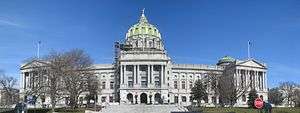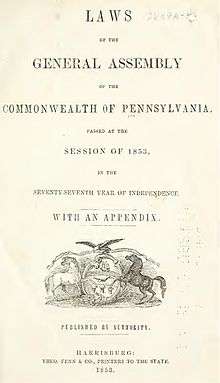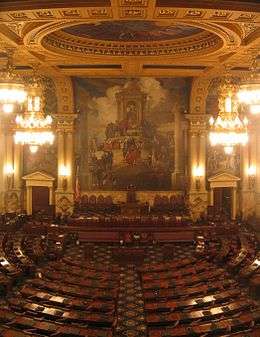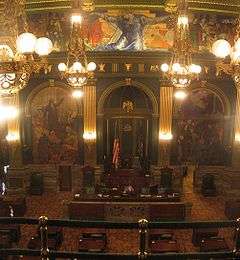Pennsylvania General Assembly
| Pennsylvania General Assembly | |
|---|---|
 | |
| Type | |
| Type | |
| Houses |
Senate House of Representatives |
| Leadership | |
Leader of the Senate | |
Leader of the House | |
| Structure | |
| Seats |
253 50 Senators 203 Representatives |
 | |
House of Representatives political groups |
Republican Party Democratic Party |
 | |
State Senate political groups |
Republican Party Democratic Party |
| Elections | |
House of Representatives last election | November 4, 2014 |
State Senate last election | November 4, 2014 |
| Meeting place | |
 | |
| Pennsylvania State Capitol | |
| Website | |
| www.legis.state.pa.us | |
The Pennsylvania General Assembly is the state legislature of the U.S. state of Pennsylvania. The legislature convenes in the State Capitol building in Harrisburg. In colonial times (1682–1776), the legislature was known as the Pennsylvania Provincial Assembly. Since the Constitution of 1776, written by American revolutionaries, the legislature has been known as the General Assembly. The General Assembly became a bicameral legislature in 1791.
History
During the mid-19th century, the frustration of the people of the Commonwealth of Pennsylvania with the extremely severe level of corruption in the General Assembly (i.e., logrolling) culminated in a constitutional amendment in 1864 which prevented the General Assembly from writing statutes covering more than one subject. Unfortunately, the amendment (today found at Section 3 of Article III of the Pennsylvania Constitution) was so poorly written that it also prevented the General Assembly from undertaking a comprehensive codification of the Commonwealth's statutes until another amendment was pushed through in 1967 to provide the necessary exception.[1] This is why today, Pennsylvania is the only U.S. state that has not yet completed a comprehensive codification of its general statutory law. Pennsylvania is currently undertaking its first official codification process in the Pennsylvania Consolidated Statutes.[2][3]
Membership
The General Assembly has 253 members, consisting of a Senate with 50 members and a House of Representatives with 203 members, making it the second-largest state legislature in the nation (behind New Hampshire) and the largest full-time legislature. As of 2014, members' base pay was $85,356,[4] making it the costliest state legislature per capita in the U.S.[5] Republicans hold a 31-19 majority in the Senate and a 120-83 majority in the House.
The Pennsylvania general elections are held on the Tuesday after the first Monday in November in even-numbered years. A vacant seat must be filled by special election, the date of which is set by the presiding officer of the respective house.
Senators must be at least 25 years old, and Representatives at least 21 years old. They must be citizens and residents of the state for a minimum of four years and reside in their districts for at least one year. Individuals who have been convicted of felonies, including embezzlement, bribery, and perjury, are ineligible for election; the state Constitution also adds the category of "other infamous crimes," which can be broadly interpreted by state courts. No one who has been previously expelled from the General Assembly may be elected.[6]
Legislative districts are drawn every ten years, following the U.S. Census. Districts are drawn by a five-member commission, of which four members are the majority and minority leaders of each house (or their delegates). The fifth member, who chairs the committee, is appointed by the other four and may not be an elected or appointed official. If the leadership cannot decide on a fifth member, the State Supreme Court may appoint him.
While in office, legislators may not hold civil office. Even if a member resigns, the Constitution states that he may not be appointed to civil office for the duration of the original term for which he was originally elected.
Legislative sessions

The General Assembly convenes at noon on the first Tuesday of January and then meets regularly throughout the year. Both houses adjourn on November 30 in even-numbered years, when the terms of all members of the House and half the members of the Senate expire. Neither body can adjourn for more than three days without the consent of the other.
The governor may call a special session in order to press for legislation on important issues. Most recently, a special session was called for the purpose of property tax reform.
The Assembly meets in the Pennsylvania State Capitol, which was completed in 1906. Under the Pennsylvania Constitution, the Assembly must meet in the City of Harrisburg and can move only if given the consent of both chambers.
General assembly leadership
Pennsylvania House of Representatives
Speaker of the House of Representatives: Mike Turzai (R) [7]
| Majority Party (R) | Leadership Position | Minority Party (D) |
| Dave L. Reed | Floor Leaders | Frank Dermody |
| Bryan Cutler | Whip | Mike Hanna |
| Sandra Major | Caucus Chair | Dan Frankel |
| Donna Oberlander | Caucus Secretary | Rosita Youngblood |
| Bill Adolph | Appropriations Committee Chairman | Joe Markosek |
| Kerry Benninghoff | Policy Committee Chairman | Mike Sturla |
| Brian Ellis | Caucus Administrator | Neal Goodman |


Pennsylvania State Senate
President pro tem of the Senate: Joseph B. Scarnati (R)
| Majority Party (R) | Leadership Position | Minority Party (D) |
| Jake Corman | Leader | Jay Costa |
| John Gordner | Whip | Anthony H. Williams |
| Bob Mensch | Caucus Chairman | Wayne Fontana |
| Rich Alloway | Caucus Secretary | Larry Farnese |
| Pat Browne | Appropriations Committee Chairman | Vincent Hughes |
| Dave Argall | Policy Committee Chairman | Lisa Boscola |
| Chuck McIlhinney | Caucus Administrator | John Yudichak |
See also
- 2005 Pennsylvania General Assembly pay raise controversy
- Pennsylvania Provincial Assembly, for the General Assembly before 1776
- Pennsylvania Legislative Black Caucus
References
- ↑ City of Philadelphia v. Commonwealth, 838 A. 2d 566 (Pa. 2003). This decision of the Supreme Court of Pennsylvania expressly acknowledges that (1) the original 1864 amendment occurred because of the General Assembly's problems with corruption; and (2) the general view that enactment of a comprehensive codification was hindered by the perception that it would have violated the pre-1967 version of Section 3.
- ↑ Prince, Mary Miles. Prince's Bieber Dictionary of Legal Citations (6th ed.). Wm. S. Hein Publishing. p. 343. ISBN 1-57588-669-3. LCCN 2001024375.
- ↑ "Pennsylvania Session Laws > FAQ". Pennsylvania Legislative Reference Bureau. Retrieved 15 August 2013.
- ↑ Associated Press (2014-11-21). "Legislators, judges and executive branch officials getting a 1.6 percent raise". Pennlive.
- ↑ "Post General Election Legislative breakdown". The Council of State Governments.
- ↑ "CONSTITUTION OF THE COMMONWEALTH OF PENNSYLVANIA: Article II - The Legislature". Pennsylvania Constitution Web Page of the Duquesne University School of Law. Duquesne University School of Law. 2010-02-11. Retrieved 2010-02-11.
- ↑ The Pennsylvania House of Representatives - Officers. Legis.state.pa.us. Retrieved on 2015-01-21.
External links
| Wikisource has original works on the topic: Pennsylvania General Assembly |

